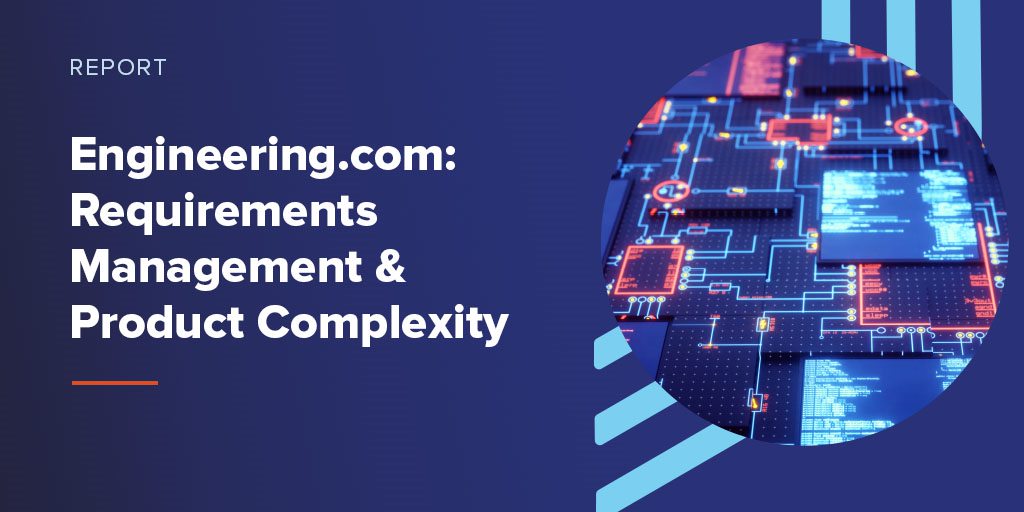Today, we’re re-running this post from January to help spread the word about our upcoming webinar that dives deep into the Engineering.com report. Register here.
A new research report from Engineering.com reveals how design and engineering professionals are approaching the increasing complexity of both their products and requirements management processes.
For the report, Design Teams: Requirements Management & Product Complexity, Engineering.com surveyed nearly 250 design and engineering professionals about the growing complexity of their company’s products and how requirements are managed amidst this changing landscape.
For a full breakdown of the Engineering.com report with guidance on how to correct some of the issues raised, register for our webinar, “The Great Cost of Poor Requirements Management.”
While Jama Software sponsored the report, the research and its subsequent editorial readout were conducted entirely independently by Engineering.com. And the results are extremely illuminating.
Product Development Increasing in Complexity
One of the biggest takeaways, especially for requirements enthusiasts like ourselves, was that even though more than 90% of respondents reported that their products had increased in complexity over the last five years, a mere 15% relied on a dedicated requirements management platform.
Driving this increase in product complexity are many factors, including how development teams have been:
- Integrating more electronic components, embedded software and microprocessors
- Increasing the intricacy of mechanical designs
- Using different materials
- Reducing weight and shrinking size
- Building connected products (IoT)
- Incorporating AI or machine learning
Given the rapid increase in product complexity, product design teams need a structured information system to handle requirements throughout each stage of product development.
Without a dedicated solution, teams are stuck with ineffective requirements management, resulting in things like product outcome failures (83% of respondents) and reprimands by regulatory agencies (62% of respondents).
The Impact of Investing in Requirements Management
Despite a high percentage of teams encountering regulatory and product outcome failures, most product teams (81% of those interviewed, in fact) believe their requirements management process to be effective.
And yet how can these requirements management processes be considered effective when the majority of teams are experiencing product outcome failures and getting penalized by regulatory agencies?
The reason for this contradiction in perception, according to Engineering.com, might be that “few teams employ a formal requirements management system. Having not purchased a system, they are dismissive and forgiving of failures while offering middling praise for the unsophisticated solutions they rely on.”
In other words, most companies don’t know what they don’t know.
Requirements Management Platforms Can Help Reduce Regulatory Reprimands
It shouldn’t be a surprise that development teams in industries that were highly regulated (66%) were more likely to use a purpose-built requirements management solution.
Perhaps not coincidentally, the analysis also showed that organizations using dedicated requirements management platforms in regulated industries not only received fewer instances of warnings, recalls, fines and production stoppages than those that didn’t, but nearly half reported experiencing none of those problems at all.
Plus, across all industries, requirements management platforms were rated highest in effectiveness overall versus any other method.
As the Engineering.com report concludes: “It is clear from the data that the products most design teams are creating are becoming more complex. Yet, they have not thought of investing in the tools available that would help them manage the requirements this complexity demands.”
Here are some other takeaways from the report:
- Product teams must manage multiple types of requirements. On average, product teams cited 4.5 different requirement types critical to their products.
- Product feature requirements are critical to 79% of respondents (the other 21% were working on less-complex products with fewer feature requirements).
- More than 4 out of 5 teams have experienced product outcome failures, including exceeding cost requirements (46%), lost time to market (38%), product shipped without meeting all requirements (36%), and excessive time spent tracing requirements (36%).
- The more sophisticated the requirements management system, the more effective it was found to be.
To dive deeper into the data about the challenges requirements management systems can solve, head over to Engineering.com and download the report, “Design Teams: Requirements Management & Product Complexity.”

